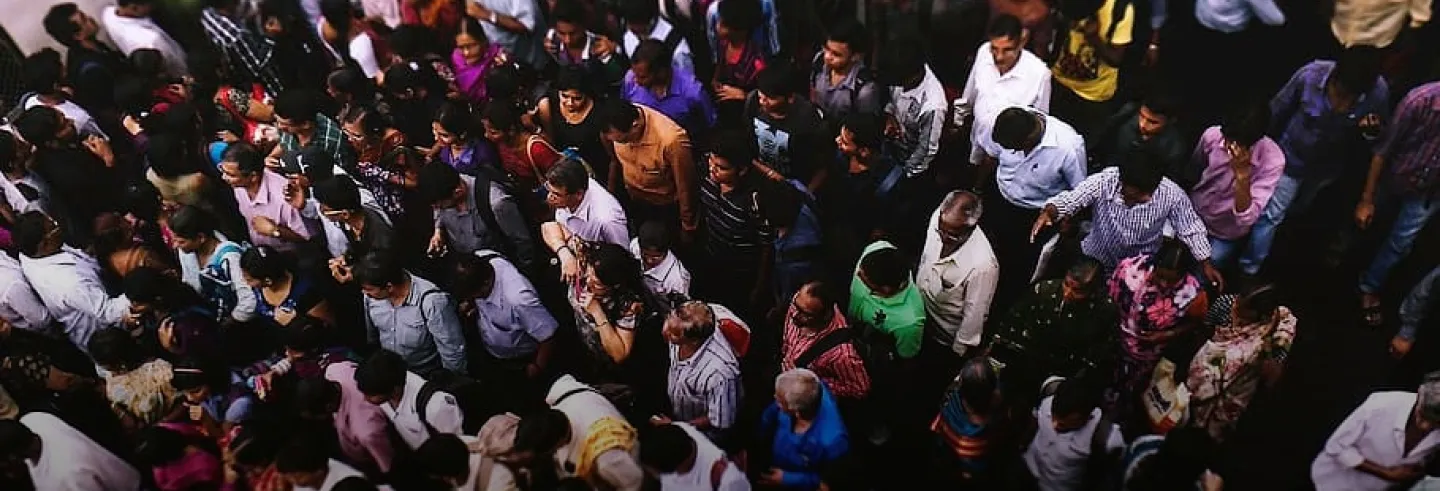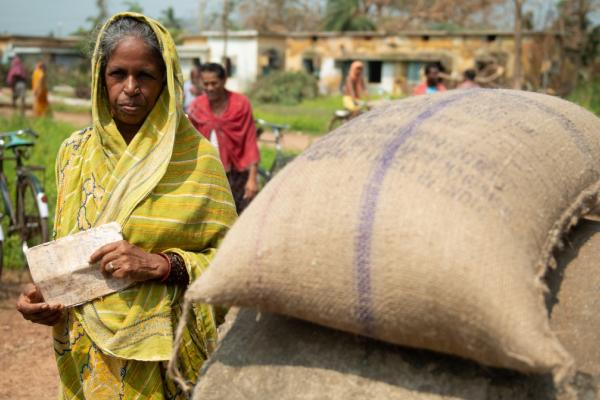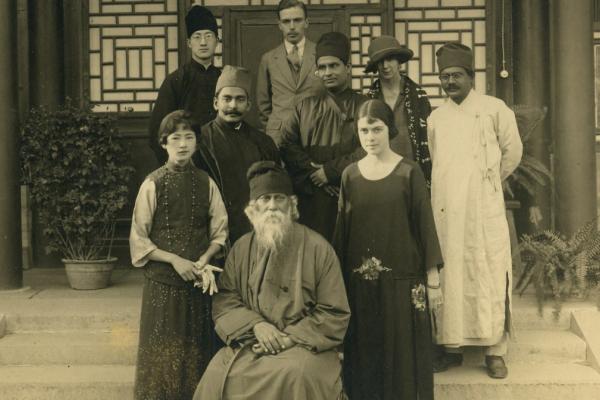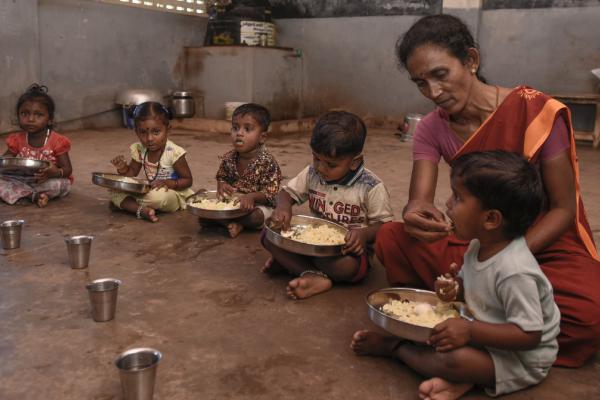India’s demographic trends have been viewed optimistically in recent years, compared to the second half of the 20th century when the discourse was about “overpopulation”. Undoubtedly, the country is now passing through a rapid fertility transition. The Total Fertility Rate (TFR) —the number of children a woman is likely to bear during her child-bearing age going by the current pattern of fertility at all ages — stands at 2.2, according to the latest (2018) data available from the official Sample Registration System (SRS).
This is close to the replacement level of 2.1, the rate at which the size of the population potentially remains stable for a few decades and thereafter does not grow. The pace of fertility decline in India has been nearly 2% per year in the past few decades, which is a faster decline than before. Overall therefore, the earlier concern about overpopulation in India has given way to discussions on the demographic dividend and the need to concentrate on the quality of population.
Yet, concerns about overpopulation continue to erupt from time to time. These concerns are dominated by two arguments. First, that since India’s population is continuing to grow, it is necessary to place a check on growth by taking major measures. This argument, as will be shown below, reflects a poor understanding of population dynamics. Achievement of replacement level fertility does not imply an immediate stabilisation of the population. This is because the fertility rate in the past was higher than today and people born in the past will reach the reproductive age group, get married and then have children. Therefore, because of this population momentum, the population will continue to grow for a while whatever the efforts taken at this juncture.
Second, a continuing concern in public policy about overpopulation is the current heterogeneity in the movement towards replacement level fertility across groups and regions in the country. There are concerns even among the general public about the differences in fertility among various religious groups. In addition, high fertility in the large states of Uttar Pradesh, Bihar, Rajasthan, and Madhya Pradesh is often cited while arguing for greater policy intervention.
The population growth rates across religious groups ... show a steady decline over the past decades.
It is, therefore, important to have a fresh look at the differences in fertility across groups, particularly among various religious groups, over a period of time to understand if the overall faster decline in fertility that we have been witnessing in recent decades encompasses all sections of the population.
The important question is whether fertility differentials have been narrowing over the years across various groups, particularly among religious groups. How far are the concerns raised in various quarters and perceptions among much of the general public in line with the empirical facts?
Population growth: A long-term view
The United Nations Population Division provides projections of the population for every country of the world till 2100. Figure 1 presents the total population and the TFR for India during the period 1950 to 2100. The population projection for India shows that India’s TFR reached the replacement level in the year 2020. As noted earlier, India's population will, however, continue to grow for the next four decades, mainly due to the population momentum effect.
The state-level picture is similar. The projection carried out by the Office of the Registrar General of India show a steady decline in the growth of population in the coming decades in all the states (Figure 2). By 2036, the growth rate over a five-year period will fall below 10% everywhere. The exception is Bihar which will be the only state with a fertility rate higher than 2 by then. The population growth differentials between states are not widening but are expected to narrow beyond 2036 as all states move towards a near zero rate of growth.
The population growth rates across religious groups also show a steady decline over the past decades. Among the two major religious groups, the growth rate among Hindus has been declining over time, so too the growth rate of the second leading religious group, the Muslims. For instance, in the decade 1951–61, the Census information showed that the population growth rate for Hindu and Muslims was 19% and 31%, respectively. By 2001–2011, the population growth rates for Hindu and Muslims had declined to 16% and 24%, respectively. Thus, the Muslim population growth rate dropped by 7 percentage points between 1951–61 to 2001–11, a more rapid decline than that of Hindus which had dropped by 3 percentage points over the same half century. In 1951, the Hindu population size was 30 crores more than the Muslim population. In 2011, the Hindu population was 80 crores more than the Muslim population (Quraishi, 2021). Apart from Muslims, up to 1991, the growth rate of the Sikh and Buddhist/Neo-Buddhist population was higher than that of the Hindus.
The differential growth rate of population across religious groups is a debate that has continued since British rule. The first Census of India that was conducted around 1872 had a question about religion. That data from the 1872 Census provided an understanding of the population strength of various religious groups in the country. Since it coincided with the electoral process, first to the municipal bodies and later to legislative assemblies during British rule, the information on the relative strength of each religious group brought forth communal reactions (Bhagat 2013). With each subsequent publication of census results by religion, such reactions continued. Thus, the syndrome of majority and minority based on religion has its origin in the late 19th century (Bhagat, 2013). This debate continued even in the first half of the 20th century with concerns about the differences in population growth rate across religious groups. India gained its independence alongside a division of the subcontinent based on religious identity. Therefore, from Independence onwards, religion, family planning, fertility, and population growth remain a subject of both an academic and political debate. Even with rapid fertility transition and decline in the population growth rate across religious groups, this discourse has failed to die down.
Fertility transition
The fertility transition in India as measured by the movement in the TFR has been fairly rapid in recent decades. According to the 2018 SRS report, the all-India fertility level that stood at 2.2 that year had shown a decline of 18.5% during the previous 10 years. Among the 22 states for which information was provided, only eight states had a TFR that was above the replacement level fertility of 2.1. The SRS report also showed a rapid decline in fertility across all states in the country between 2006-08 and 2016-18: the TFR declined by nearly 23% in Uttar Pradesh, 18% in Madhya Pradesh, 15% in Bihar, and 24 % in Rajasthan.
It is important to note that in the 1950s, a woman would experience an average of six births, a number which has declined to two children per woman in recent times, below the replacement level. According to the National Family Health Surveys carried out at frequent intervals, the TFR has declined from 3.4 in 1992-93, to 2.2 in 2015–16 (Figure 3). The National Family Health Survey for the fifth round (NFHS-5) results for the period 2019–21 are awaited, but given the trajectory of the recent transition in fertility, the country will most likely be at below replacement level fertility when the NFSH-5 results are announced.
There are significant regional differences in fertility between the states and districts. The findings from the National Family Health Survey (2015–16) show that the TFR is as low as 1.56 children per woman in Kerala and as high as 3.4 children per woman in Bihar.
The debate on religion and fertility in India has often revolved around a few perceptions. First, that the fertility rate is higher among the Muslims than the Hindus and this may lead to Muslims outnumbering Hindus in India in the 21st century. Second, that contraceptive use is lower among Muslims because Islam prohibits the use of contraceptive methods. Third, that due to polygamy among Muslims, the fertility rate among Muslims will be higher than in other communities.
Among various religious groups, the Muslims recorded the fastest decline in fertility during the last two decades.
However, the validity of these concerns is often not carefully examined. Using the ample and reliable data available, we make here a detailed examination of these concerns.
Muslims have shown a higher fertility rate than Hindus from the time large-scale quantitative data has become available. During 1891–1931, the fertility of Muslims was about 15% higher than that of the Hindu population (Visaria 1974). Even in independent India, various reports and studies have reported that there is higher fertility among Muslims (Visaria 1974).
The reports of the National Family Health Survey also have shown similar patterns. The Muslim population has a higher fertility rate than of other religious groups. For instance, the Muslim TFR was around 4.4 children per woman among all religious groups in 1992–93 (Figure 4).
Given the trajectory of fertility transition, there is no possibility of Muslims overtaking Hindus in population size in India.
However, one must note that the rate of decline in fertility has been the fastest among Muslims. The TFR among Muslims declined from 4.4 to 2.61 between 1992–93 and 2015–16. This decline of Muslim fertility between 1992–93 and 2015–16 was to the tune of 41%, while that of Hindus was 35%. Among various religious groups, the Muslims recorded the fastest decline in fertility during the last two decades. This clearly shows that Muslims will also be reaching replacement level fertility soon. Given the trajectory of fertility transition, there is no possibility of Muslims overtaking Hindus in population size in India. We also see from Figure 4 that there is a convergence in fertility rate across the major religious groups in the country.
A recent study has estimated the Hindu and Muslim fertility across the districts of India (Ghosh 2018). A scatter plot of Hindu and Muslim fertility across districts from the data provided by the study is presented in Figure 5. It would appear that in districts where Hindu fertility is high, Muslim fertility is high, and where Hindu fertility is low then Muslim fertility is also low, suggesting that it is not religion that influences the level of fertility.
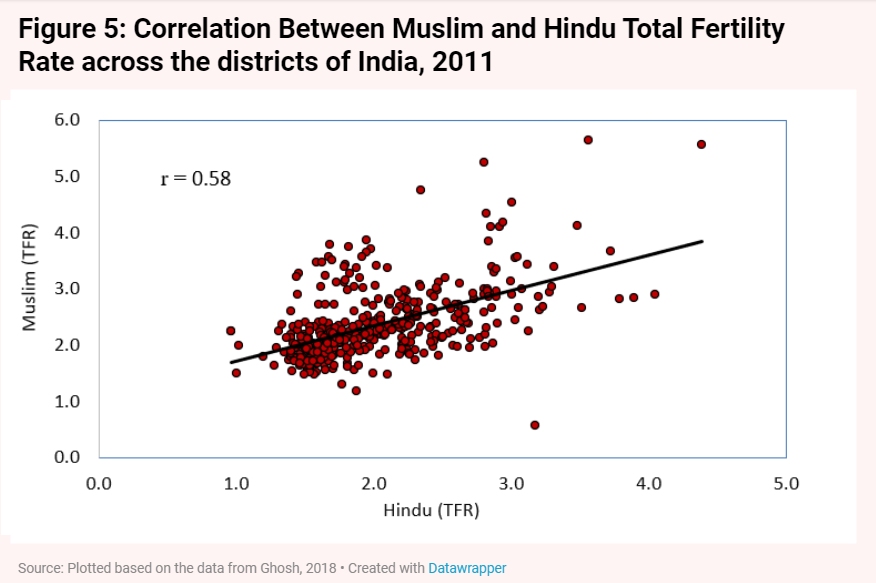
The findings of Ghosh (2018) show that there are several districts with below replacement level fertility, both among Hindus and Muslims. It is noted from the data presented in this study that the TFR among the Hindus is either at or below the replacement level of fertility in a majority of the north-western and eastern states. This is so in the southern states as well. Among the Muslims, the TFR is below replacement level in several states such as Odisha, Andhra Pradesh, and Tamil Nadu. There are many states where the TFR among Muslims is very close to the replacement level: West Bengal, Chhattisgarh, Gujarat, Karnataka, Kerala, and some northeast Indian states. During the decade 2001–11, a significant decline in TFR among Muslims has been registered in several states such as Haryana, Assam, Delhi, West Bengal, and Jharkhand.
Contraceptive use
The major drivers of fertility transition in India have been through use of contraceptives . Contraceptive use in the country has shown a significant improvement over the last several decades, though there was a marginal decline in use in 2015–16. (Figure 6).
There has been a debate among Muslims on the acceptance of family planning methods. Omran (1992) noted that only some Islamic scholars obstruct the use of family planning methods and that the majority of Islamic scholars say there are no issues in Muslims using contraceptive methods. This is perhaps one of the reasons behind the low fertility rate in many Muslim-majority countries in the world.
There is significant variation in the use of contraceptive methods across religious groups of India (Figure 7). Contraceptive use among the Muslim community remains low compared to other religious groups. A low contraceptive use among a community may emerge due to two reasons, namely, demand and supply-side factors. Although assessing these the role of these two factors is not easy, demand and supply-side factors may be assessed by the ideal number of children desired by women (demand) and the unmet need for family planning (supply).
Across religions, the Muslim community has the highest proportion of unmet needs for family planning.
Many fertility surveys ask a question of women: “If you go back to a time to when you did not have any children and could choose the number of children you would want over your whole life, how many children would you ideally desire?” This “ideal number of children” is often considered to be “the desired number of children for a woman”. If the ideal number of children is high, the demand for the contraceptive method would be low and vice-versa. On the other hand, the unmet need for family planning implies that there are women who do not want to get pregnant but are not using a contraceptive method. If a community has a higher level of unmet need for family planning, it implies the presence of supply bottlenecks in terms of provision of services.
The NFHS (2015–16) shows that the ideal number of children in India is 2.15. The ideal number of children among the Hindus, Muslims, and Christians are 2.10, 2.50, and 2.26 children per woman, respectively. Although there is a small variation across religious groups, the ideal number of children in any religion does not exceed 2.5 children per woman. Sometimes, the actual number of children exceeds the ideal number of children, mainly because of the presence of the unmet need for family planning. About 13% of women in reproductive age groups have an unmet need for family planning in India (Figure 8). Across religions, the Muslim community has the highest proportion of unmet needs for family planning. Thus, this community needs a greater policy focus because a higher fertility among Muslims may have partially resulted from an unmet need for family planning services.
Discussion
There are indeed differences in fertility across all religious groups in India. At the same time, a large set of reliable data also clearly indicates that the current wave of fertility transition — of declining fertility among women — embraces all religious groups. Groups like Muslims, which in the past had a higher fertility than others have recorded a faster decline in fertility in recent years.
The fertility trajectory across religious groups in India presents a few interesting patterns. First, Muslim fertility is high wherever Hindu fertility is also high. The regional patterns of fertility are therefore very significant for understanding the fertility trajectory among different sections of the population. Regions with high fertility continue to have high fertility levels among all groups, irrespective of religion, caste, or educational background. However, in regions with low fertility, all sections of the population have achieved replacement level fertility.
[I]t is not the fertility differentials between, say, religious groups, that matter, which are natural in any setting, but it is the pace of transition that provides a better idea of the trajectory of the fertility transition.
Second, fertility differentials exist among various sections of the population in almost all the regions, both in high fertility settings and low fertility settings where the replacement level has already been achieved. These differentials are linked to major social and economic characteristics such as education, caste, religion, and economic status. Although fertility levels between groups have significantly narrowed in the low fertility settings, small differentials still persist, depending on several social and economic characteristics. It is also important to understand that such differences existed even before the fertility transition began in the country. Hence, it is not the fertility differentials between, say, religious groups, that matter, which are natural in any setting, but the pace of transition that will provide a better idea of the trajectory of the fertility transition. For instance, the district-level estimates of fertility show that out of 618 districts of India, 54% have replacement level fertility among Hindus and 35% of the districts have replacement level fertility among Muslims (Ghosh 2018). Among both Hindus and Muslims, the number of districts achieving below replacement level fertility increased considerably between 2001 and 2011.
Third, the available evidence suggests that fertility in India is converging across various religious groups. This is expected in a fertility transition phase and India is not an exception. Fourth, the data on marriage patterns across religious groups available from the National Family Health Survey (2015–16) shows that the men aged 15–54 years who have multiple wives is 0.45% among the Muslims and 0.24% among the Hindus (IIPS & ICF, 2017). Thus, the notion that Muslim men follow a polygamous relationship is not based on any reliable empirical data. Moreover, the very fact that there is a shortage of women in India due to the skewed sex ratio (951 women per 1,000 men in India, according to the 2011 Census) does not provide men an option of having a polygamous relationship.
Concluding remarks
We have shown that there is a convergence in demographic indicators across religious groups in the country. The drop in the population growth rate was higher among Muslims than among Hindus in the last census decade (2001–11). Although fertility among Muslims is higher than among the Hindus, there is a clear sign of a convergence in fertility rates between these two communities. Thus, there is no chance that the Muslim population would ever outnumber the Hindu population in the country.
The inter-state and inter-district differentials in fertility are of far greater importance than the differences in fertility across religious groups.
The increase in the share of the Muslim population in the total population, to 14% in 2011 from 10% in 1951, is in part a reflection of the higher fertility among Muslims in the past, when the gap between Muslim and Hindu fertility was much wider than today. With the narrowing of the gap in fertility that has been taking place in recent decades, the respective shares in total population will stabilise.
The faster decline in fertility among Muslims in recent times is leading to a convergence in fertility levels across religious groups. Moreover, the inter-state and inter-district differentials in fertility are of far greater importance than the differences in fertility across religious groups. It is also found that the use of family planning among Muslims has gone up over the decades, similar to the rise in other religious communities. However, the practice of contraceptive use remains low due to demand and supply-side factors. A significant proportion of the higher fertility among Muslims can be attributed to higher unmet needs for family planning. This calls for policy intervention to ensure quality family planning services to the most vulnerable groups of people in India.


